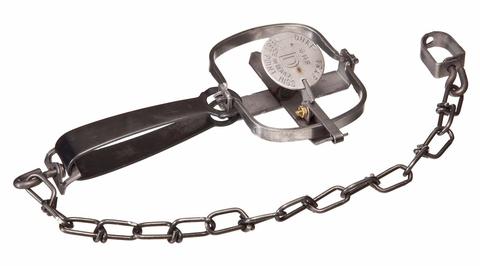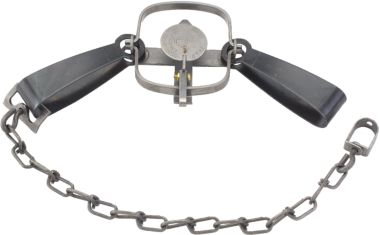 The long spring trap is one of the oldest types of footholds in existence, and is still commonly used today. It is a simple, well-functioning trap built to last. Long spring traps come in many different sizes, and two configurations – single spring and double spring.
The long spring trap is one of the oldest types of footholds in existence, and is still commonly used today. It is a simple, well-functioning trap built to last. Long spring traps come in many different sizes, and two configurations – single spring and double spring.
The basics behind the long spring trap are simple. When the trap’s jaws are opened, one or two long metal springs are compressed and held that way by the tension of the jaws, which are held open with a trigger controlled by a pan. When the pan moves and the trigger releases, the spring opens, which forces the jaws shut.
Because it is relatively simple, durable and long lasting, the long spring trap is still popular today. However, there are a few downsides to the trap. Because of the long, bulky springs, the trap is difficult to bed when using on land sets. It is usually impossible to adjust the pan tension, and adjusting the spring location to keep the jaws laying flat can be a pain. Still, the long spring has its place as a valuable fur harvesting tool.
The long spring trap comes in many different sizes designed for different animals.
The #0 long spring trap is typically a 3.5″ jaw spread single spring trap designed for catching very small animals like weasels and squirrels.
The #1 long spring trap is typically 4″ jaw spread single spring trap designed for catching small animals like mink and muskrat.
 The #11 long spring trap is a 4″ jaw spread double spring trap designed for catching mink and muskrat, and the extra spring gives it the holding power for raccoon as well.
The #11 long spring trap is a 4″ jaw spread double spring trap designed for catching mink and muskrat, and the extra spring gives it the holding power for raccoon as well.
The #1 1/2 long spring trap is a single spring trap with a typical jaw spread of around 4 3/4″. It’s a good mink and muskrat trap, with the advantage of having some extra weight for drowning sets. It can also hold skunks and raccoons.
The #2 long spring trap is a double spring trap with a jaw spread of around 5″. This is a good raccoon and fox trap. It can be used for coyotes and otter, and in some cases beaver.
The #3 long spring trap is a double spring trap with a jaw spread of around 5 3/4″. It’s mainly a coyote and beaver trap, and is also used for otter, bobcat, badger and lynx.
The #4 long spring is a double spring trap with a typical jaw spread of 6″. It’s a great beaver, otter or coyote trap.
The #5 long spring is a double spring trap with a typical jaw spread of 7 1/2″. This is a big trap. Wolves and beavers, mainly.